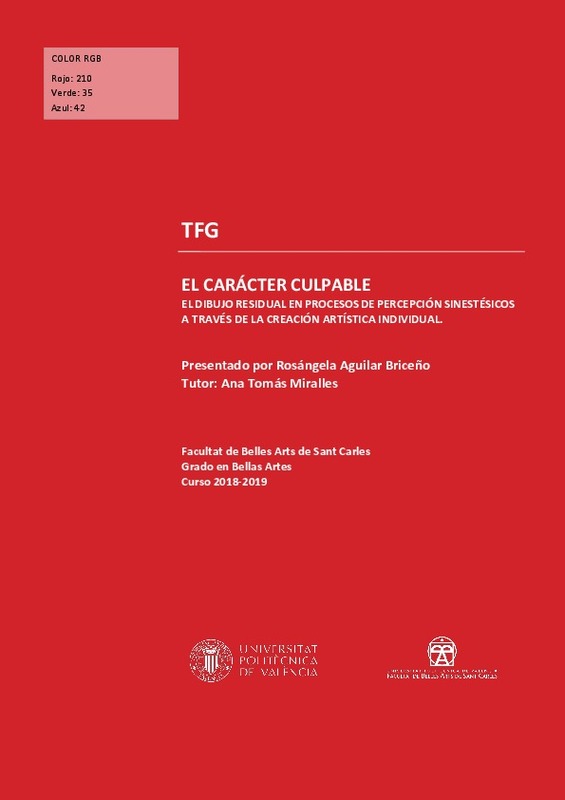JavaScript is disabled for your browser. Some features of this site may not work without it.
Buscar en RiuNet
Listar
Mi cuenta
Estadísticas
Ayuda RiuNet
Admin. UPV
EL CARÁCTER CULPABLE. El dibujo residual en procesos de percepción sinestésicos a través de la creación artística individual
Mostrar el registro sencillo del ítem
Ficheros en el ítem
| dc.contributor.advisor | Tomás Miralles, Ana de los Dolores
|
es_ES |
| dc.contributor.author | Aguilar Briceño, Rosangela Jose
|
es_ES |
| dc.date.accessioned | 2019-10-31T10:03:01Z | |
| dc.date.available | 2019-10-31T10:03:01Z | |
| dc.date.created | 2019-07-12 | |
| dc.date.issued | 2019-10-31 | es_ES |
| dc.identifier.uri | http://hdl.handle.net/10251/130101 | |
| dc.description.abstract | [ES] En la contemporaneidad cuantificar el nivel de micro-sensaciones y micro-percepciones recibidas por segundo en el cerebro aún parece un reto para la ciencia. El bombardeo de imágenes condiciona al habitante de la metrópolis a un input constante: incluso teniendo tecnologías para adaptarse al medio, la rapidez del contexto urbano sobre estimula y somete al cuerpo a un conjunto de fuerzas tecnológicas. La discusión actual sobre la política de los cuerpos humanos revela una necesidad de investigar en los efectos de la dinámica de la máquina en los colectivos más minoritarios, siendo el grupo de diversidad funcional una realidad factible de producción creativa que plantee desafíos tanto somática como teóricamente. Es a través de un análisis visual de las interrelaciones entre dichas personas y el contexto que les circunda en donde la anécdota, el arte y la vida se conectan en este proyecto dibujístico para constituir un lenguaje gráfico personal. Las micro-sensaciones provocadas por el contexto a nivel fisiológico dirimen el desarrollo gráfico de las obras en un vaivén físico hasta alcanzar un nivel de conciliación con la misma, el cénit: el acabado definitivo. El remanente visual de la artista, en el proceso de generar la obra, utiliza la configuración perceptiva concebida desde la agenesia metacarpiana. Generando una abstracción que, guiada por la investigación y experimentación plástica, emplea el dibujo como medio expresivo. Con la obra resultante se quiere afianzar un proceso creativo individual cuyas fases protagonizadas por técnicas aditivas de líneas gestuales y caligráficas, se enmarañen en registros expresivos yuxtapuestos. | es_ES |
| dc.description.abstract | [EN] In contemporaneity, quantifying the level of micro-sensations and micro-perceptions received per second in the brain still seems a challenge for science. The bombardment of images conditions the inhabitant of the metropolis to a constant input: even by having technologies for adapting to the environment, the speed of the urban context over stimulates and subjects the body to a set of technological forces. The current discussion on the politics the body reveals a need to investigate the effects of machine dynamics on minority groups. The disabled diversity collective is a feasible reality of creative production that proposes challenges both somatically and theoretically. It is through visual analysis of the interrelationships between these people and the context that surrounds them where anecdotes, art and life are connected on this drawing project to constitute a personal graphic language. Micro-sensations caused by the context at the physiological level decide the graphic development of the works in a physical oscillation until reaching a level of conciliation with it, the zenith: the finishing. The visual remnant of the artist, while in process of generating the work, uses the perceptual configuration conceived from metacarpal agenesis. Generating an abstraction that, guided by research and plastic experimentation, uses Drawing as an expressive medium. With the resulting work, consolidating an individual creative process whose phases, carried out by additive techniques of gestural and calligraphic lines, become entangled in juxtaposed expressive registers, is wanted. | es_ES |
| dc.language | Español | es_ES |
| dc.publisher | Universitat Politècnica de València | es_ES |
| dc.rights | Reconocimiento - Sin obra derivada (by-nd) | es_ES |
| dc.subject | Gesto | es_ES |
| dc.subject | Entorno | es_ES |
| dc.subject | Residuo | es_ES |
| dc.subject | Dibujo | es_ES |
| dc.subject | Grafismo | es_ES |
| dc.subject | Proceso | es_ES |
| dc.subject | Agenesia física | es_ES |
| dc.subject | Gesture | es_ES |
| dc.subject | Environment | es_ES |
| dc.subject | Residue | es_ES |
| dc.subject | Drawing | es_ES |
| dc.subject | Graphism | es_ES |
| dc.subject | Physical Agenesis | es_ES |
| dc.subject.classification | DIBUJO | es_ES |
| dc.subject.other | Grado en Bellas Artes-Grau en Belles Arts | es_ES |
| dc.title | EL CARÁCTER CULPABLE. El dibujo residual en procesos de percepción sinestésicos a través de la creación artística individual | es_ES |
| dc.type | Proyecto/Trabajo fin de carrera/grado | es_ES |
| dc.rights.accessRights | Abierto | es_ES |
| dc.contributor.affiliation | Universitat Politècnica de València. Centro de Investigación Arte y Entorno - Centre d'Investigació Art i Entorn | es_ES |
| dc.contributor.affiliation | Universitat Politècnica de València. Departamento de Dibujo - Departament de Dibuix | es_ES |
| dc.contributor.affiliation | Universitat Politècnica de València. Facultad de Bellas Artes - Facultat de Belles Arts | es_ES |
| dc.description.bibliographicCitation | Aguilar Briceño, RJ. (2019). EL CARÁCTER CULPABLE. El dibujo residual en procesos de percepción sinestésicos a través de la creación artística individual. http://hdl.handle.net/10251/130101 | es_ES |
| dc.description.accrualMethod | TFGM | es_ES |
| dc.relation.pasarela | TFGM\99001 | es_ES |
Este ítem aparece en la(s) siguiente(s) colección(ones)
-
BBAA - Trabajos académicos [5086]
Facultad de Bellas Artes




![[File]](/themes/UPV/images/mime.png)


